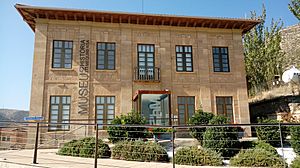Aiguabarreig (Mequinenza) facts for kids
Aiguabarreig is a very special natural area in Mequinenza, Spain. It's a place where three big rivers meet: the Ebro, Segre, and Cinca. This makes it the largest river meeting point in the Iberian Peninsula and one of the biggest in all of Europe! It's super important for animals, especially birds, as they use it for breeding, spending the winter, or resting during their long migrations. Many people think it's one of the most amazing natural spots in Aragon.
Contents
What Does "Aiguabarreig" Mean?
The word "Aiguabarreig" comes from the Catalan language. It means "mixing of waters." This name perfectly describes the area where two or more rivers come together to form one bigger river. First, the Cinca river joins the Segre river near La Granja d'Escarp. Then, these combined waters flow into the Ebro river when they reach Mequinenza.
Where is Aiguabarreig?
This natural area is in the middle of the Ebro Valley. To the west, it's next to the Monegros Desert, and to the south, it touches the Ribarroja reservoir. This big natural space is shared between two parts of Spain: Aragon and Catalonia. The Segre and Cinca rivers first meet between the towns of La Granja d'Escarp, Massalcoreig, and Torrente de Cinca. A few kilometers later, their waters join the Ebro river in Mequinenza.
Aiguabarreig in Mequinenza is part of a protected area called the Matarranya-Aiguabarreig Special Protection Area. This area helps protect the wildlife and nature.
The Amazing Landscape
Aiguabarreig has wide rivers, many river islands, and large forests along the riverbanks. You can also find big areas of reed beds, pebble beaches, and special river bends called "galachos." It's a unique place where plants from the dry Monegros meet plants from the Mediterranean area.
The landscape here is very different. You have a huge wetland where the three rivers meet, right next to very dry, arid land. This makes it a perfect spot for many birds. They come here to spend the winter, raise their young, or stop for a rest during their long journeys. Because it's in the middle of the Ebro valley and close to the Ebro Delta Natural Park, Aiguabarreig acts like a super important natural bridge for animals.
Plants and Animals
You can find different kinds of plants in Aiguabarreig, like pine trees, rosemary, and some types of oak and juniper. Along the rivers, there are trees like white poplar, white willow, and tamarisk. In the water, you'll see reeds.
This mix of environments means many different animals live here. Birds are the most common group. You can see colonies of herons on the river islands and many types of birds of prey. There are also birds that like dry desert areas. Many of these birds are rare or endangered in Europe.
Other animals you might spot include reptiles, amphibians, and mammals. There are many kinds of bats, lots of deer, and even otters. You might even see wild goats from the town or near the castle of Mequinenza.
The Ribarroja reservoir has created new islands where the Segre and Cinca rivers meet the Ebro. One of these, Illa dels Martinets, is now a big nesting place for many heron species, like egrets and night herons.
The forests along the rivers and the reed beds are home to many interesting birds all year round, such as Rail (bird)s, Thrush (bird)es, and Finches. In the drier areas, you can find birds like the Little bustard and different types of sandgrouse. On the cliffs, you'll see many birds of prey, including the Griffon vulture, Golden eagle, and Peregrine falcon.
The amphibians and reptiles in Aiguabarreig include different kinds of toads, frogs, turtles, and snakes.
Fun Activities and History
Sport fishing and boating are very popular activities in Aiguabarreig. Fishermen from all over the world, especially Europe, come here to catch fish like black bass, pike-perch, and the famous catfish. Many nature lovers and birdwatchers also visit because of the amazing variety of plants and animals.
The area around Aiguabarreig has a long history of coal mining, going back over 150 years. The rivers were important for transporting the coal using special boats called "llauts." You can still see old mining buildings and structures along the rivers.
The Museums of Mequinenza tell the story of the mining past and the Old Town of Mequinenza. The old town was flooded when the Ribarroja and Mequinenza reservoirs were built. At the Museum of the Mine, you can explore a real coal mine tunnel, over a kilometer long, and see old mining machines. The Museum of the History of Mequinenza shows the town's past, from ancient times to the flooding of the old town. It also has a section about the writer Jesús Moncada, who was from Mequinenza.
The Castle of Mequinenza stands high on a steep cliff where the Ebro, Segre, and Cinca rivers meet. It's a very old castle, built in the 14th and 15th centuries, and offers amazing views of the rivers and surrounding lands. On clear days, you can even see the Pyrenees mountains! It's one of the best examples of Gothic castle architecture in the Crown of Aragon.
You can also visit parts of the old town of Mequinenza today. After it was flooded, some of the old streets and houses that were above the water were saved. It's like an outdoor memory park where you can walk through the old streets, see parts of the old church, and imagine what life was like in this ancient town of sailors and miners on the banks of the Ebro river.
See also
 In Spanish: Aiguabarreig (Mequinenza) para niños
In Spanish: Aiguabarreig (Mequinenza) para niños



